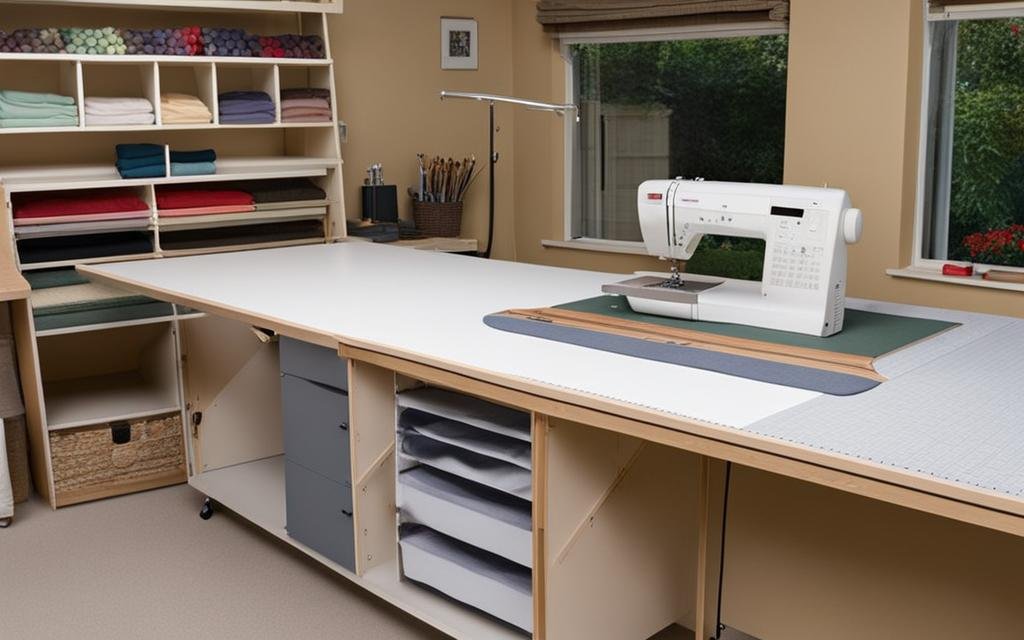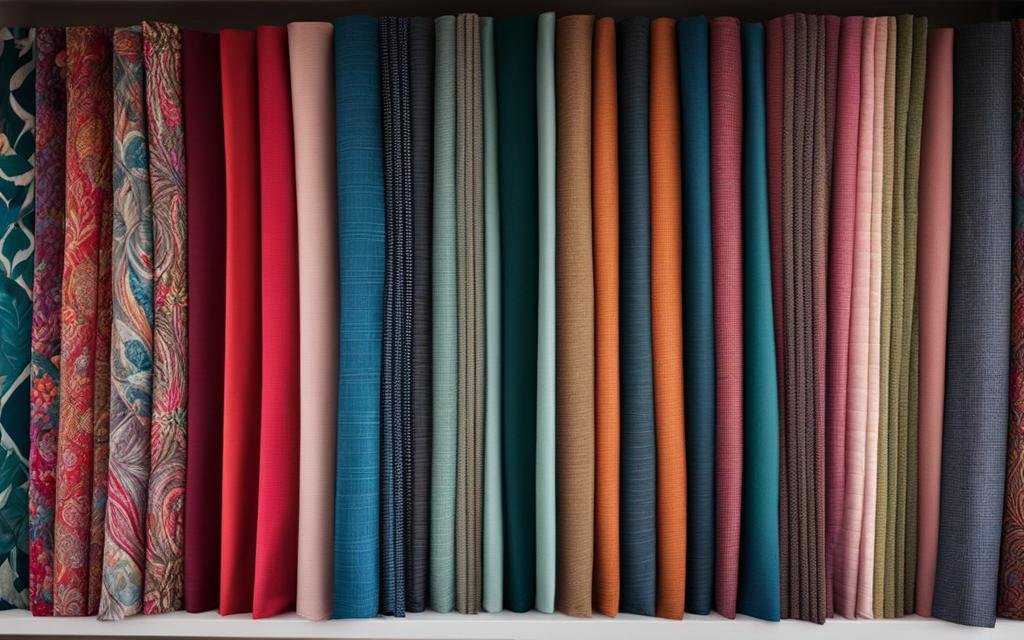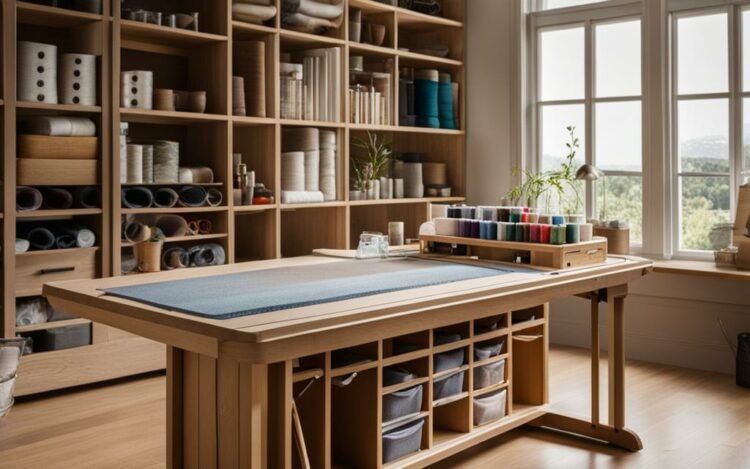A sewing cutting table is an essential piece of furniture for any sewing enthusiast. It provides a dedicated space for cutting fabric and other materials, offering a flat and stable surface that makes the cutting process easier and more precise. In this thorough guide, we will explore everything you need to know about sewing cutting tables, from their requirements and features to their construction and organization.
Key Takeaways:
- Investing in a sewing cutting table can greatly enhance your sewing experience.
- Consider the requirements of a cutting table, such as height and storage capacity.
- DIY options, like using IKEA Kallax units, allow for a personalized cutting table.
- Ensure your cutting table is well-organized with proper storage solutions.
- Choosing an ironing station is an important aspect of setting up your sewing workspace.
- Ready to revamp your sewing setup? Explore SewingMachinesPlus.com coupon codes for discounts on sewing cabinets, cutting tables, and other furniture to optimize your crafting space.
Requirements for a Cutting Table
When it comes to choosing a sewing cutting table, there are several key requirements that you should keep in mind. These requirements will ensure that you have a functional and ergonomic workspace that enhances your sewing experience. Here are the essential factors to consider:
- Height: The table should be at a comfortable height for cutting without straining your back. Consider your own height and preferences when selecting a table.
- Storage: Look for a table that offers ample storage compartments or shelves. This will help you keep your tools and materials, such as fabric bolts, rulers, and irons, organized and within easy reach.
- Ironing Station: It’s beneficial to choose a table that doubles as an ironing station. This eliminates the need for a separate ironing board and saves space in your sewing room.
- Cutting Mat: Ensure that the table has a large cutting mat that accommodates the size of fabric you work with. A spacious cutting surface allows for precise and efficient cutting.
- Portability: Consider the portability and maneuverability of the table. This allows you to access stored items easily and rearrange your sewing room if needed.
By considering these requirements, you can select a cutting table that meets your needs and provides a comfortable and organized workspace for your sewing projects.

Choosing the Right Cutting Table
When it comes to choosing the right cutting table for your sewing room, there are a few important factors to take into account. These factors will ensure that your cutting table is both functional and practical for your needs:
- Size: Consider the size of the table and make sure it provides enough workspace for comfortable cutting and maneuvering of fabric.
- Height: The height of the table should be suitable for your height and working preferences, allowing you to reach the surface without straining.
- Storage Capacity: Look for tables with built-in shelves, drawers, and cubbies to keep your sewing space organized and your tools easily accessible.
- Design and Aesthetics: Consider the overall design and aesthetics of the table, as it should complement the decor of your sewing room and create an inviting workspace.
By considering these factors, you can choose a cutting table that not only meets your practical needs but also enhances the overall look and feel of your sewing room.
DIY Sewing Cutting Table
If you prefer a more personalized approach to your sewing cutting table, you can create your own DIY sewing cutting table. This allows you to customize the table according to your specific needs and preferences. One popular option is to use IKEA Kallax units as a base for your cutting table. These units are versatile and can be easily customized to provide ample storage space.
To create your DIY sewing cutting table, start by adding storage inserts to the Kallax units. This will allow you to organize your sewing tools, fabric, and other materials conveniently. You can also add wheels to the units for easy mobility, making it easier to rearrange your sewing room if needed.
Next, attach a sturdy melamine top to the Kallax units. This will provide you with a flat and stable surface for cutting fabric. Make sure to choose a top that is large enough to accommodate the size of fabric you typically work with.
Overall, building a DIY sewing cutting table gives you the flexibility to design a table that perfectly fits your sewing room and workflow. It allows you to create a functional and versatile workspace with ample storage, making your sewing projects more organized and enjoyable.
Choosing the Right Cutting Table
In order to create an organized and efficient sewing workspace, it’s important to choose the right cutting table. Consider the following factors when selecting a cutting table for your sewing room:
Size and Workspace
First and foremost, consider the size of the cutting table. It should provide enough workspace for comfortable cutting and maneuvering of fabric. Ensure that the table is large enough to accommodate the size of fabric you typically work with. A spacious cutting table will make it easier to measure and cut fabric accurately.
Height
The height of the cutting table is crucial for your comfort and posture while working. Look for a table with an adjustable height feature or choose a table that is specifically designed for cutting and sewing. The ideal height is one that allows you to stand or sit comfortably while working, without straining your back or shoulders.
Storage Capacity
Effective storage is key to keeping your sewing workspace organized. Look for cutting tables that have built-in shelves, drawers, and cubbies. These storage compartments will provide ample space to store your tools, accessories, and materials. Keeping everything within reach will save you valuable time and energy during your sewing projects.
Design and Aesthetics
Lastly, consider the design and aesthetics of the cutting table. Choose a table that complements the overall decor of your sewing room. A visually appealing table will create a pleasant and inviting workspace. Additionally, opt for a table that is made of quality materials and is built to last.
By carefully considering these factors, you can choose the right cutting table that meets your needs and helps you create a well-organized and functional sewing workspace. Take the time to research and explore different options before making your final decision.
Building a Cutting Table
Building your own cutting table can be a rewarding and cost-effective project. With some basic tools and materials, you can create a custom table that suits your sewing needs perfectly. Here are the steps to assemble your cutting table:
- Choose the base: Start by selecting a sturdy base for your cutting table. As mentioned earlier, IKEA Kallax units are a popular choice due to their versatility and storage capabilities.
- Attach the units: Position the Kallax units according to your desired table dimensions and secure them together using screws or brackets. Ensure that the units are level and stable.
- Add the tabletop: Measure and cut a piece of plywood to fit the dimensions of the Kallax units. Place the plywood on top of the units and secure it with screws or adhesive.
- Create the work surface: Cover the plywood with a heat-resistant melamine surface to protect it from damage and provide a smooth cutting surface. Secure the melamine with adhesive or screws.
Once your cutting table is assembled, you can further customize it based on your preferences. Consider adding additional storage options like shelves, drawers, or fabric bins to keep your sewing essentials organized and easily accessible. Don’t forget to add a comfortable chair or stool to complete your sewing workstation.
Benefits of Building Your Own Cutting Table
Building your own cutting table offers several benefits. Firstly, you have full control over the dimensions and design, allowing you to create a table that perfectly fits your sewing space and workflow. Additionally, DIY tables often provide more storage options, ensuring that all your tools and materials have a dedicated place. Lastly, building your own cutting table can be a cost-effective solution compared to purchasing a pre-made table, making it a budget-friendly project for sewing enthusiasts.
Organizing Your Cutting Table

Now that your sewing cutting table is built, it’s time to organize it efficiently. A well-organized cutting table can greatly enhance your sewing workflow, making it easier to find and access your tools and materials. Here are some tips to help you optimize your cutting table’s organization:
Fabric Storage
Utilize the vertical space above your cutting table to store fabric bolts. You can install a shelf or use a wire storage system to hang fabric bolts, allowing you to easily see and access your fabric collection.
Ruler Storage
To keep your rulers within reach, attach hooks or racks to the sides of your cutting table. This will prevent them from cluttering the table’s surface and make it convenient for you to grab the right ruler for each project.
Iron Storage
Having a designated spot for your iron is essential for a well-organized cutting table. Choose a heat-resistant iron holder that can be easily accessed while you work. This will help you keep your iron within reach and prevent any accidents or damage to your table.
Sewing Workspace Organization
Utilize the storage compartments and drawers of your cutting table to organize works in progress (WIPs) and remnants. By keeping your unfinished projects and scraps neatly stored, you can maintain a clutter-free workspace and streamline your sewing process.
By implementing these organization tips, you can create an efficient and functional sewing workspace. A well-organized cutting table will not only make your projects more enjoyable but also save you time and energy in the long run.
Choosing an Ironing Station
When setting up your sewing cutting table, it’s important to consider the ironing station as well. The ironing station provides a convenient space for pressing and ironing fabric during your sewing projects. There are a few options to choose from depending on your preferences and space constraints.
Ironing Surface on the Table
One option is to have the ironing surface directly on the cutting table itself. This allows you to maximize space and have everything within reach. Ensure that the surface of your table is heat-resistant and won’t be damaged by the hot iron. You can use a heat-resistant pad or cover the table with a layer of heat-resistant fabric to protect it.
Separate Ironing Board
If you have enough space in your sewing room, you may choose to have a separate ironing board. This allows for a dedicated ironing station that can be positioned next to your cutting table. Look for an ironing board that is sturdy and adjustable in height to suit your needs. Consider the size of the board and ensure that it fits comfortably in your sewing room without causing any obstructions.
Whichever option you choose, make sure that your ironing station is easily accessible and doesn’t hinder your workflow. Having a designated space for ironing will help you achieve crisp, professional-looking seams and finished garments. Keep your pressing tools, such as a spray bottle and pressing cloths, nearby for efficient ironing.
Remember, the ironing station is an important component of your sewing setup. Choose the option that works best for you and your sewing space, ensuring that it complements your cutting table and contributes to a productive sewing environment.
Conclusion
A sewing cutting table is an essential piece of furniture for any sewing enthusiast. It provides a dedicated space for cutting fabric and other materials, offering a flat and stable surface that makes the cutting process easier and more precise.
Whether you choose to purchase a pre-made table or embark on a DIY project, a well-designed and organized cutting table can greatly enhance your sewing experience. By considering the requirements, choosing the right table, and organizing it effectively, you can create a functional and efficient sewing workspace.
Invest in a sewing cutting table that meets your needs and enjoy the benefits of a dedicated space for cutting fabric and creating beautiful projects. Make your sewing room complete with this essential piece of sewing room furniture.

